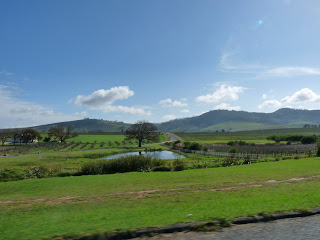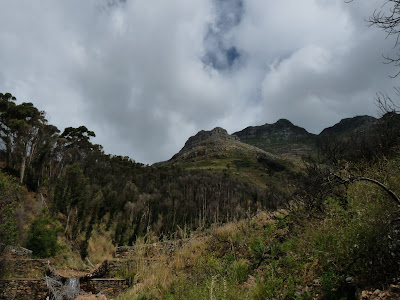 My first apartment
My first apartment
I’ve moved. My lease on my place downtown was up, and even though I love the apartment, I couldn’t afford it anymore. Plus the lease on my parking space was also finished, and I wasn’t exactly keen to park on the street. Real estate in Cape Town is a tricky affair. It’s not so bad, as it is in New York, that you have to read the Obits to find a place, but it’s close. From what I’ve heard, real estate agents are not very helpful (I didn’t get one, though I was close to it once I really started having trouble). Like most denizens of Cape Town, I used Gumtree, the local Craigslist, to search for a place. You have to be on your toes, refreshing the page every half hour or so and calling places immediately upon posting, and you have to be OK with rejection. For every five replies I sent out, I got a single response, and most of the time it was to say that the flat wasn’t furnished or didn’t have parking or was already taken. Once you have requirements—in my case, a fully furnished place, with a parking spot, in a security complex, in a safe neighborhood, for under a certain amount—things get harder. I looked at dumpy places, a few that were so small I didn’t think I could live in them (the test was whether I could turn around in the kitchen or not), and one place that was so popular—the location was amazing—that there were people lined up to view it. I arranged to look at a couple of places in slightly sketchy neighborhoods before deciding it wasn’t worth the risk.

View from my new place
All the places had a view, though. It may be impossible to live in Cape Town and not have a view, and it’s breathtaking every time, even though it might mean that on a clear day if you stick your head out the bathroom window you can see Lion’s Head. I almost took one of those shoebox flats because it had a full panoramic view of Table Mountain, but the miniscule kitchen, and the fact that the closet was in the bathroom, did me in.
After a long search, I found a good place. It’s located in the Vredehoek neighborhood, in Devil's Peak, right under the peak of the same name (the mountain to the left of Table Mountain). Apparently, it’s also “Windy City” as one co-worker called it, and she warned that I wouldn’t sleep at night. The fact that a nearby street is called “Windburg” does not bode well, though Vredehoek means “Corner of Peace” in Afrikaans. And so, I moved into Devil’s Peak on Halloween. The apartment is small, a studio, with a kitchen, washing machine, and large balcony. A bar separates the main area from the kitchen. The complex itself is quite large, and not a building so much as a cluster of apartments. It reminds me somewhat of a resort I once stayed in on the outskirts of Tucson, Arizona. Oh, and the views are spectacular—the ocean, the mountain, and the city are all visible.
 The Shire/On the way to Stellenbosch
The Shire/On the way to Stellenbosch
With the certainty that this will reveal my nerdy-ness even more, Cape Town and South Africa in general often feel very Lord of the Rings-y (as a good friend calls it). Tolkien was born in what was the Orange Free State, South Africa (I actually didn’t know this—someone told me recently), though he moved to England at a young age. However, I can’t help but think, upon moving here, that South Africa must have imprinted something on young Tolkien’s imagination, though I know that his travels in Switzerland and England played a huge part in shaping his Middle Earth (the Jungfrau and Silberhorn, or Young Lady and Silver Horn mountains; the English bogs and countryside; English towns named Kingston Upon Hull and Swiss ones called Grindelwald...).
 At Kirstenbosch Gardens
At Kirstenbosch Gardens
“Windburg” and other place names certainly evoke Tolkien’s works for me, as does the stark, stunning beauty of Cape Town and the surrounding area—the jutting mountains, bits of green between the rocks, the howling wind, the wildflowers. Trees possess names like silverleaf (or silwerboom); flowers, King, or Honeypot, Protea. Outside the city, there are little farmhouses in green fields with little brooks and ponds. There are lush forests that can feel welcoming and ordered in a natural way, or dark and old and a bit foreboding. There is wine country and steep, rocky, barren land, seas dashing themselves on rocks, and winter nights with warm, simple food.
 A silwerboom
A silwerboom
Mulling over all of this brought me to origin tales about Cape Town and its unique setting (I used to rock climb, so I will admit that I also looked into the actual geology, but I won’t torture anyone with it here).
It’s said that a Dutchman, Jan van Hunks, lived in a little cottage at the foot of a mountain that was called Windburg in his day. He was known far and wide as an exceptional and dedicated smoker and had won many wagers on his talent. Jan’s wife did not allow him to smoke his pipe in the house, and so, he would wander out onto Windburg to enjoy his favored pastime. One day, while smoking on the slopes of the mountain, he met a stranger carrying a pipe. They struck up a conversation that turned to a series of boasts about which of the two smoked more. This, naturally, led to a contest between Jan and the stranger. They smoked and smoked until they created a cloud that floated up and over Table Mountain. Finally, Jan prevailed, and as the stranger turned to go, his red tail peaked out from under his clothes. Van Hunks realized that he had beaten the Devil himself. The mountain was renamed Duiwelspiek, or Devil’s Peak, and the cloud of smoke that the two created still wafts over Table Mountain when the Southeaster, or Cape Doctor, is blowing. It’s now called the Tablecloth, and when it appears, it’s said that Jan and the Devil are at it again.
 Lion's Head (doesn't it look like Weathertop?)
Lion's Head (doesn't it look like Weathertop?)
Table Mountain features in an epic poem, Os Lusiadas, by the Portuguese poet Luís Vaz de Camões. The poem is seen as the Portuguese Iliad or Aeneid. At the beginning of the world, Kronos and his siblings, the Titans, were overthrown by Kronos’ children, the Olympians. The most mainstream version in Greek mythology details that after the battle, most of the Titans were imprisoned in the deepest pit of Tartarus, while the remaining were granted places in the Olympian pantheon by Zeus. De Camões veers from this line, writing that the Olympians banished the Titans to the farthest reaches of the earth. Zeus had the Titan Adamastor imprisoned in stone at the southernmost tip of the world, forming Table Mountain. Centuries or millennia later, Adamastor was angered by the navigator, Vasco de Gama, who trespassed on his territory while rounding the Cape of Good Hope in the attempt to tap the spice wealth of India by establishing a sea route to Asia. Adamastor tossed the Portuguese ship in storm after storm, but the piously Catholic De Gama and his crew prevailed over the “heathen” demigod, eventually reaching India (and, in case you were interested, another sailor associated with the Cape is the Flying Dutchman, but I won’t get into that story here).
A !Xhosa origin story tells that Qamata, one of the focal deities in the !Xhosa pantheon and the child of the sun god and earth goddess, Thixo and Jobela, wanted to make dry land, but the sea dragon Nkanyamba interfered. Jobela created four giants to aid Qamata in his efforts. After their task was complete, Qamata turned the giants to stone to keep watch over the land in the four cardinal directions. Umlindi Wemingizimu, the Watcher of the South, became Table Mountain.
 Table Mountain, with Tablecloth, seen from Lion's Head
Table Mountain, with Tablecloth, seen from Lion's Head
It speaks to the tumultuous and convoluted history of the Cape region, and all of South Africa, that there are stories from so many backgrounds. From the first Khoi inhabitants (in keeping with the uneven nature of African history, I could not easily find much information on the web about pre-European incursions) to the Portuguese, then Dutch, and then British, South Africa has been crisscrossed by many peoples and fought over for centuries. Everything in the Cape is a mix of indigenous Africa, Europe, and Asia (from the slaves brought over to work), from the Afrikaans language before the “impure” non-white elements were expunged; to the food, which combines curries and meatloaf; to the "coloured" population itself.
PS: I'm not sure why this post (and others) has different font sizes--I don't know anything about the actual Html/code side of blogging, so I apologize if it's weird or jarring to you. I have no idea how to change it--I think it's a code error.

















